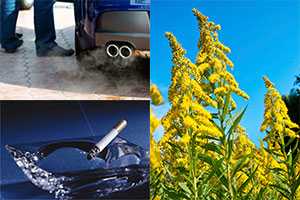Common Asthma Triggers

If you have asthma, an asthma attack can happen when you are exposed to “asthma triggers.” Your triggers can be very different from those of someone else with asthma. Know your triggers and learn how to avoid them. Watch out for an attack when you can’t avoid the triggers. Some of the most common triggers are:
Tobacco Smoke
Tobacco smoke is unhealthy for everyone, especially people with asthma. If you have asthma and you smoke, quit smoking.
“Secondhand smoke” is smoke created by a smoker and breathed in by a second person. Secondhand smoke can trigger an asthma attack. If you have asthma, people should never smoke near you, in your home, in your car, or wherever you may spend a lot of time.
Dust Mites
Dust mites are tiny bugs that are in almost every home. If you have asthma, dust mites can trigger an asthma attack. To prevent attacks, use mattress covers and pillowcase covers to make a barrier between dust mites and yourself. Don’t use down-filled pillows, quilts, or comforters. Remove stuffed animals and clutter from your bedroom. Wash your bedding on the hottest water setting.
Outdoor Air Pollution
Outdoor air pollution can trigger an asthma attack. This pollution can come from factories, cars, and other sources. Pay attention to air quality forecasts on radio, television, and the Internet and check your newspaper to plan your activities for when air pollution levels will be low.
Cockroach Allergen
Cockroaches and their droppings can trigger an asthma attack. Get rid of cockroaches in your home by removing as many water and food sources as you can. Cockroaches are often found where food is eaten and crumbs are left behind. At least every 2 to 3 days, vacuum or sweep areas that might attract cockroaches. Use roach traps or gels to cut down on the number of cockroaches in your home.
Pets
Furry pets can trigger an asthma attack. If you think a furry pet may be causing attacks, you may want to find the pet another home. If you can’t or don’t want to find a new home for the pet, keep it out of the person with asthma’s bedroom.
Bathe pets every week and keep them outside as much as you can. People with asthma are not allergic to their pet’s fur, so trimming the pet’s fur will not help your asthma. If you have a furry pet, vacuum often. If your floors have a hard surface, such as wood or tile, damp mop them every week.
Mold
Breathing in mold can trigger an asthma attack. Get rid of mold in your home to help control your attacks. Humidity, the amount of moisture in the air, can make mold grow. An air conditioner or dehumidifier will help you keep the humidity level low. Get a small tool called a hygrometer to check humidity levels and keep them as low as you can—no higher than 50%. Humidity levels change over the course of a day, so check the humidity levels more than once a day. Fix water leaks, which let mold grow behind walls and under floors.
Smoke From Burning Wood or Grass
Smoke from burning wood or other plants is made up of a mix of harmful gases and small particles. Breathing in too much of this smoke can cause an asthma attack. If you can, avoid burning wood in your home. If a wildfire is causing poor air quality in your area pay attention to air quality forecasts on radio, television, and the Internet and check your newspaper to plan your activities for when air pollution levels will be low.
Other Triggers
Infections linked to influenza (flu), colds, and respiratory syncytial virus (RSV) can trigger an asthma attack. Sinus infections, allergies, breathing in some chemicals, and acid reflux can also trigger attacks.
Physical exercise; some medicines; bad weather, such as thunderstorms or high humidity; breathing in cold, dry air; and some foods, food additives, and fragrances can also trigger an asthma attack.
Strong emotions can lead to very fast breathing, called hyperventilation, that can also cause an asthma attack.
Remember, you can control your asthma!
The above text is adapted from the "You Can Control Your Asthma" [PDF - 4074 KB] full-color brochure and is suitable for downloading and printing.
Top of Page- Page last reviewed: December 14, 2010
- Page last updated: August 20, 2012
- Content source:


 ShareCompartir
ShareCompartir